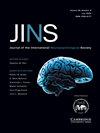使用美国国立卫生研究院工具箱认知平板电脑电池识别黑人和白人社区老年人的失忆性轻度认知障碍
IF 2.6
4区 心理学
Q2 CLINICAL NEUROLOGY
Journal of the International Neuropsychological Society
Pub Date : 2024-09-18
DOI:10.1017/s1355617724000213
引用次数: 0
摘要
目标:确定美国国立卫生研究院工具箱认知测验(NIHTB-CB)的哪些子测验最能区分健康对照组(HC)和失忆性轻度认知障碍(AMCI)患者:确定哪些 NIH 工具箱认知测试(NIHTB-CB)子测试最能区分健康对照组(HC)和伴有失忆性轻度认知障碍(aMCI)的患者,并比较使用先验 "规范调整 "分数与 "未调整 "标准分数的模型之间的判别准确性,同时在模型中控制年龄、性别、种族/民族和教育程度。此外,还研究了种族差异。研究方法受试者为黑人/非洲裔美国人(B/AA)和白人共识确认(HC = 96;aMCI = 62)的 60-85 岁成年人,他们完成了 NIHTB-CB 药片。在总样本中使用了判别函数分析 (DFA),并分别对黑人/非洲裔美国人(n = 80)和白人参与者(n = 78)进行了分析。结果在所有 DFA 模型中,图片序列记忆(一种外显记忆任务)的负荷系数最高。如果按种族进行分层,则会发现 DFA 中最高负载系数的模式存在差异。然而,DFA 模型在识别 HC 和 aMCI 患者方面的总体判别准确性并没有因种族(B/AA、白人)或模型/评分类型(规范调整与未调整)的不同而产生显著差异。结论:尽管使用了规范化评分或人口统计学协变量,但仍发现了种族差异--这凸显了将代表性不足的群体纳入研究的重要性。虽然模型在识别共识确认的高危人群方面相当准确,但在识别被诊断为 aMCI 的白人参与者方面,模型的准确性较低。在临床环境中,需要进一步优化计算机化电池,建议使用 NIHTB-CB 标准调整分数。在研究环境中,建议使用人口统计学校正分数或模型内校正。本文章由计算机程序翻译,如有差异,请以英文原文为准。
Identification of amnestic mild cognitive impairment among Black and White community-dwelling older adults using NIH Toolbox Cognition tablet battery
Objectives: Identify which NIH Toolbox Cognition Battery (NIHTB-CB) subtest(s) best differentiate healthy controls (HC) from those with amnestic mild cognitive impairment (aMCI) and compare the discriminant accuracy between a model using a priori “Norm Adjusted” scores versus “Unadjusted” standard scores with age, sex, race/ethnicity, and education controlled for within the model. Racial differences were also examined. Methods: Participants were Black/African American (B/AA) and White consensus-confirmed (HC = 96; aMCI = 62) adults 60–85 years old that completed the NIHTB-CB for tablet. Discriminant function analysis (DFA) was used in the Total Sample and separately for B/AA (n = 80) and White participants (n = 78). Results: Picture Sequence Memory (an episodic memory task) was the highest loading coefficient across all DFA models. When stratified by race, differences were noted in the pattern of the highest loading coefficients within the DFAs. However, the overall discriminant accuracy of the DFA models in identifying HCs and those with aMCI did not differ significantly by race (B/AA, White) or model/score type (Norm Adjusted versus Unadjusted). Conclusions: Racial differences were noted despite the use of normalized scores or demographic covariates—highlighting the importance of including underrepresented groups in research. While the models were fairly accurate at identifying consensus-confirmed HCs, the models proved less accurate at identifying White participants with an aMCI diagnosis. In clinical settings, further work is needed to optimize computerized batteries and the use of NIHTB-CB norm adjusted scores is recommended. In research settings, demographically corrected scores or within model correction is suggested.
求助全文
通过发布文献求助,成功后即可免费获取论文全文。
去求助
来源期刊
CiteScore
5.40
自引率
3.80%
发文量
185
审稿时长
4-8 weeks
期刊介绍:
The Journal of the International Neuropsychological Society is the official journal of the International Neuropsychological Society, an organization of over 4,500 international members from a variety of disciplines. The Journal of the International Neuropsychological Society welcomes original, creative, high quality research papers covering all areas of neuropsychology. The focus of articles may be primarily experimental, applied, or clinical. Contributions will broadly reflect the interest of all areas of neuropsychology, including but not limited to: development of cognitive processes, brain-behavior relationships, adult and pediatric neuropsychology, neurobehavioral syndromes (such as aphasia or apraxia), and the interfaces of neuropsychology with related areas such as behavioral neurology, neuropsychiatry, genetics, and cognitive neuroscience. Papers that utilize behavioral, neuroimaging, and electrophysiological measures are appropriate.
To assure maximum flexibility and to promote diverse mechanisms of scholarly communication, the following formats are available in addition to a Regular Research Article: Brief Communication is a shorter research article; Rapid Communication is intended for "fast breaking" new work that does not yet justify a full length article and is placed on a fast review track; Case Report is a theoretically important and unique case study; Critical Review and Short Review are thoughtful considerations of topics of importance to neuropsychology and include meta-analyses; Dialogue provides a forum for publishing two distinct positions on controversial issues in a point-counterpoint format; Special Issue and Special Section consist of several articles linked thematically; Letter to the Editor responds to recent articles published in the Journal of the International Neuropsychological Society; and Book Review, which is considered but is no longer solicited.

 求助内容:
求助内容: 应助结果提醒方式:
应助结果提醒方式:


